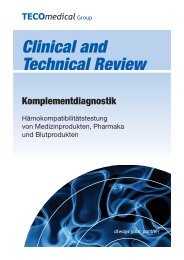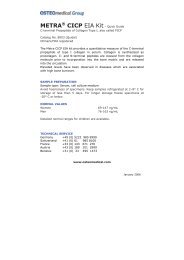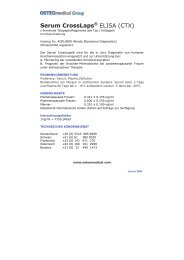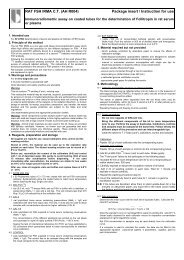Page 1 E N G LIS H D E U T S C H ITA LIA N O F R A N Ç A IS E S P ...
Page 1 E N G LIS H D E U T S C H ITA LIA N O F R A N Ç A IS E S P ...
Page 1 E N G LIS H D E U T S C H ITA LIA N O F R A N Ç A IS E S P ...
You also want an ePaper? Increase the reach of your titles
YUMPU automatically turns print PDFs into web optimized ePapers that Google loves.
Accuracy<br />
Comparative studies were performed to assess the correlations between measurements of serum bone-specific alkaline<br />
phosphatase (BAP) obtained using the Metra BAP assay to results obtained using three currently marketed methods for measuring<br />
total alkaline phosphatase (TAP) or BAP. The studies were conducted at an independent clinical investigational site, utilizing sera<br />
from 114 patients with <strong>Page</strong>t’s disease and 464 healthy subjects. The first comparative method was a colorimetric technique for the<br />
measurement of TAP. The correlation coefficient (r) obtained between this colorimetric method and the Metra BAP assay was 0.99.<br />
The second comparative method was an electrophoresis method for the determination of BAP isoenzyme levels (r = 0.99). The<br />
third comparative method was an immunoradiometric assay for the measurement of BAP (r = 0.99). Of the 114 patients diagnosed<br />
with <strong>Page</strong>t’s disease, 101 patients had values greater than the upper limit of the reference ranges for the Metra BAP assay. Thirteen<br />
patients had values less than the upper limit of the reference ranges.<br />
CLINICAL STUDIES<br />
Use of Metra BAP for Monitoring the Efficacy of Antiresorptive Therapy in Osteoporosis<br />
A multicenter, randomized controlled trial was successfully conducted to establish the safety and efficacy of the Metra BAP assay<br />
to monitor changes in serum BAP concentrations associated with amino-bisphosphonate (alendronate) antiresorptive therapy.<br />
Subjects, drawn from a larger study of the efficacy of alendronate for treating osteoporosis, 7 were postmenopausal women, aged<br />
45 to 84 years (mean 64 ± 7 years), diagnosed with osteoporosis (based on clinical presentation or baseline lumbar spine bone<br />
mineral density [LSBMD] more than 2.5 standard deviations below the mean for mature premenopausal women). At baseline,<br />
eligible subjects were randomized to receive either 10 mg alendronate and 500 mg calcium per day (ALN) or placebo and 500 mg<br />
calcium per day (CTL). Serum specimens were obtained at baseline, 3, 6 and 12 months from all subjects.<br />
Mean (± 1SD) baseline BAP concentration (14.6 ± 5.4 vs. 14.6 ± 4.6, p = 0.900) and LSBMD (0.74 ± 0.10 vs. 0.75 ± 0.09,<br />
p = 0.751) were similar values for ALN and CTL. Distributions of baseline BAP values in ALN and CTL are depicted in the following<br />
figure by proportion of the study population.<br />
6<br />
Proportion of Population (%)<br />
30.0%<br />
25.0%<br />
20.0%<br />
15.0%<br />
10.0%<br />
5.0%<br />
0.0%<br />
< 4.0<br />
4.0 – 5.9<br />
6.0 – 7.9<br />
Distribution of BAP Levels At Baseline<br />
8.0 – 9.9<br />
10.0 – 11.9<br />
12.0 – 13.9<br />
BAP was significantly lower for ALN than CTL at 3 (9.6 ± 3.5 vs. 13.4 ± 4.0, p









![PTH [Hormone Parathyroïdienne] Intacte ELISA](https://img.yumpu.com/1233682/1/190x245/pth-hormone-parathyroidienne-intacte-elisa.jpg?quality=85)






